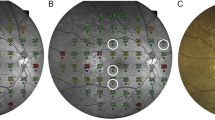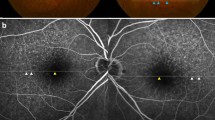Abstract
Background
To analyze the morphological and functional characteristics of malattia leventinese.
Methods
This was a chart review of patients with Malattia Leventinese. All patients underwent a complete ophthalmologic examination, including best-corrected visual acuity (BCVA), fundus autofluorescence (FAF), fluorescein angiography (FA), indocyanine green angiography (ICGA), and optical coherence tomography (OCT). Microperimetry and Preferential Hyperacuity Perimeter (PHP) were performed in a subset of patients.
Results
Twelve eyes of six patients were included. BCVA ranged from 20/25 to 20/200. The largest drusen were round, not radially distributed, localized in the perimacular area and around the optic disc. The smallest drusen were not round, radially distributed, mostly localized temporally to the macula. FAF revealed an intense autofluorescence of large drusen. On both FA and ICGA, large round drusen turned to hyperfluorescent in the late phase, while small radial drusen progressively decreased their fluorescence. OCT showed the large round drusen as focal or diffuse deposition of hyperreflective material between the RPE and Bruch membrane within the macula, determining focal dome-shaped or diffuse RPE elevation respectively, and the small radial drusen, which ranged from irregular slight thickening of the RPE/Bruch membrane complex to sawtooth RPE elevation. In three patients (six eyes) that underwent microperimetry and PHP, there was a good correspondence between macular sensitivity and PHP score. Functional impairment correlated topographically to sub-RPE deposition of drusenoid material.
Conclusions
In this series, large round drusen of Malattia Leventinese appeared similar to drusen in age-related macular degeneration, while small radial drusen of Malattia Leventinese shared similarities with early-onset cuticular drusen.





Similar content being viewed by others
References
Gass JD (1973) Drusen and disciform macular detachment and degeneration. Arch Ophthalmol 90:206–217
Pauleikhoff D, Barondes MJ, Minassian D, Chisholm IH, Bird AC (1990) Drusen as risk factors in age-related macular disease. Am J Ophthalmol 109:38–43
Vogt A (1925) Die Ophthalmoskopie im rotfreien Licht. In: Graefe A, Saemisch T (eds) Handbuch der gesamten Augenheilkunde. Untersuchungsmethoden, 3rd ed. Verlag von Wilhelm Engelman, Leipzig, pp 1–118
Piguet B, Haimovici R, Bird AC (1995) Dominantly inherited drusen represent more than one disorder: a historical review. Eye 9:34–41
Stone EM, Lotery AJ, Munier FL, Héon E, Piguet B, Guymer RH, Vandenburgh K, Cousin P, Nishimura D, Swiderski RE, Silvestri G, Mackey DA, Hageman GS, Bird AC, Sheffield VC, Schorderet DF (1999) A single EFEMP1 mutation associated with both Malattia Leventinese and Doyne honeycomb retinal dystrophy. Nat Genet 22:199–202
Matsumoto M, Traboulsi EI (2001) Dominant radial drusen and Arg345Trp EFEMP1 mutation. Am J Ophthalmol 131:810–812
Michaelides M, Jenkins SA, Brantley MA Jr, Andrews RM, Waseem N, Luong V, Gregory-Evans K, Bhattacharya SS, Fitzke FW, Webster AR (2006) Maculopathy due to the R345W substitution in fibulin-3: distinct clinical features, disease variability, and extent of retinal dysfunction. Invest Ophthalmol Vis Sci 47:3085–3097
Marmorstein LY, Munier FL, Arsenijevic Y, Schorderet DF, McLaughlin PJ, Chung D, Traboulsi E, Marmorstein AD (2002) Aberrant accumulation of EFEMP1 underlies drusen formation in Malattia Leventinese and age-related macular degeneration. Proc Natl Acad Sci USA 99:13067–13072
Guigui B, Leveziel N, Martinet V, Massamba N, Sterkers M, Coscas G, Souied EH (2011) Angiography features of early onset drusen. Br J Ophthalmol 95:238–244
Landa G, Rosen RB, Garcia PM, Seiple WH (2009) Combined three-dimensional spectral OCT/SLO topography and microperimetry: steps toward achieving functional spectral OCT/SLO. Ophthalmic Res 43:92–98
Alster Y, Bressler NM, Bressler SB, Brimacombe JA, Crompton RM, Duh YJ, Gabel VP, Heier JS, Ip MS, Loewenstein A, Packo KH, Stur M, Toaff T, Preferential Hyperacuity Perimetry Research Group (2005) Preferential hyperacuity perimeter (PreView) for detecting choroidal neovascularization study. Ophthalmology 112:1758–1765
Bloom SM, Singal IP (2011) The outer Bruch membrane layer: A previously undescribed spectral-domain optical coherence tomography finding. Retina 31:316–323
Zweifel SA, Engelbert M, Laud K, Margolis R, Spaide RF, Freund KB (2009) Outer retinal tubulation: A novel optical coherence tomography finding. Arch Ophthalmol 127:1596–1602
Cohen SY, Dubois L, Nghiem-Buffet S, Ayrault S, Fajnkuchen F, Guiberteau B, Delahaye-Mazza C, Quentel G, Tadayoni R (2010) Retinal pseudocysts in age-related geographic atrophy. Am J Ophthalmol 150:211–217
von Ruckmann A, Fitzke FW, Bird AC (1999) Distribution of pigment epithelium autofluorescence in retinal disease state recorded in vivo and its change over time. Graefes Arch Clin Exp Ophthalmol 237:1–9
von Ruckmann A, Schmidt KG, Fitzke FW, Bird AC, Jacobi KW (1998) Fundus autofluorescence in patients with hereditary macular dystrophies, Malattia Leventinese, familial dominant and aged-related drusen. Klin Monatsbl Augenheilkd 213:81–86
von Ruckmann A, Fitzke FW, Bird AC (1997) Fundus autofluorescence in age related macular disease imaged with a scanning laser ophthalmoscope. Invest Ophthalmol Vis Sci 38:478–486
Lois N, Owens SL, Coco R, Hopkins J, Fitzke FW, Bird AC (2002) Fundus autofluorescence in patients with age-related macular degeneration and high risk of visual loss. Am J Ophthalmol 133:341–349
Kitagawa K, Nishida S, Ogura Y (1989) In vivo quantitation of autofluorescence in human retinal pigment epithelium. Ophthalmologica 199:116–121
Pauleikhoff D, Zuels S, Sheraidah GS, Marshall J, Wessing A, Bird AC (1992) Correlation between biochemical composition and fluorescein binding of deposits in Bruch’s membrane. Ophthalmology 99:1548–1553
Arnold JJ, Quaranta M, Soubrane G, Sarks SH, Coscas G (1997) Indocyanine green angiography of drusen. Am J Ophthalmol 124:344–356
Scheider A, Neuhauser L (1992) Fluorescence characteristics of drusen during indocyanine-green angiography and their possible correlation with choroidal perfusion. Ger J Ophthalmol 1:328–334
Curcio CA, Millican CL, Bailey T, Kruth HS (2001) Accumulation of cholesterol with age in human Bruch’s membrane. Invest Ophthalmol Vis Sci 42:265–274
Li CM, Clark ME, Rudolf M, Curcio CA (2007) Distribution and composition of esterified and unesterified cholesterol in extra-macular drusen. Exp Eye Res 85:192–201
Russell SR, Gupta RR, Folk JC, Mullins RF, Hageman GS (2004) Comparison of color to fluorescein angiographic images from patients with early-adult onset grouped drusen suggests drusen substructure. Am J Ophthalmol 137:924–930
Collins ET (1913) A pathological report upon a case of Doyne’s chorioditis (‘Honeycomb’ or ‘family’ choroiditis). The ophthalmoscope 11:537–538
Dusek J, Streicher T, Schmidt K (1982) Hereditary drusen of Bruch’s membrane II: Studies of semi-thin sections and electron microscopy results. Klin Monatsbl Augenheilkd 181:79–83
Fu L, Garland D, Yang Z, Shukla D, Rajendran A, Pearson E, Stone EM, Zhang K, Pierce EA (2007) The R345W mutation in EFEMP1 is pathogenic and causes AMD-like deposits in mice. Hum Mol Genet 16:2411–2422
Leng T, Rosenfeld PJ, Gregori G, Puliafito CA, Punjabi OS (2009) Spectral domain optical coherence tomography characteristics of cuticular drusen. Retina 29:988–993
Querques G, Guigui B, Leveziel N, Querques L, Coscas G, Soubrane G, Souied EH (2011) Insights into pathology of cuticular drusen from integrated confocal scanning laser ophthalmoscopy imaging and corresponding spectral domain optical coherence tomography. Graefes Arch Clin Exp Ophthalmol 249:1617–1625
Evans K, Gregory CY, Wijesuriya SD, Kermani S, Jay MR, Plant C, Bird AC (1997) Assessment of the phenotypic range seen in doyne honeycomb retinal dystrophy. Arch Ophthalmol 115:904–910
Gass JDM, Jallow S, Davis B (1985) Adult vitelliform macular detachment occurring in patients with basal laminar drusen. Am J Ophthalmol 99:445–459
Financial or material support for the research and the work
None.
The authors have no proprietary interest in the materials used in this study.
Author information
Authors and Affiliations
Corresponding author
Rights and permissions
About this article
Cite this article
Querques, G., Guigui, B., Leveziel, N. et al. Multimodal morphological and functional characterization of Malattia Leventinese. Graefes Arch Clin Exp Ophthalmol 251, 705–714 (2013). https://doi.org/10.1007/s00417-012-2106-5
Received:
Revised:
Accepted:
Published:
Issue Date:
DOI: https://doi.org/10.1007/s00417-012-2106-5




